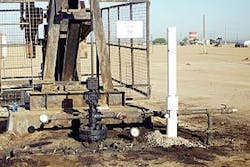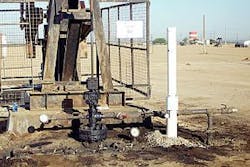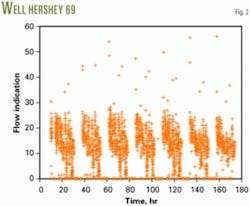New flow sensors, successfully tested on several California wells, can lower the cost of monitoring marginal oil wells, according to the US Department of Energy's (DOE's) National Energy Technology Laboratory (NETL).
DOE partially funded the development of the sensors and NETL managed the project that involved assessing the inexpensive monitoring-system prototype for improving the efficiency of sucker-rod pumped oil wells.
Petrolects LLC, San Luis Obispo, Calif., installed the marginal-expense oil well wireless surveillance (MEOWWS) monitoring system at three Vaquero Energy Co. wellsites in the mature Edison oil field in Kern County, Calif. All wells in this shallow heavy-oil field are on sucker-rod pumps.
DOE and Vaquero shared the $150,000 project cost for the 24-month project on a 50/50 basis.
MEOWWS
The installation of the MEOWWS system entails attaching small, self-contained, wireless proprietary flow sensors to a well's flowline and then analyzing the flow data's variations to determine fluid flow conditions.
Fig. 1 shows the white vertical polyvinyl chloride (PVC) pipe that houses the sensor circuit board, microcontroller, and radio.
Jim Barnes, project manager with the NETL, indicated that the system would cost a couple of hundred dollars per well, substantially less than currently available systems.
NETL expects that the MEOWWS installation for Edison field could increase oil production from a well by 3-10%, decrease electricity costs by 10% (about $2,000/month), increase pump life by about 10%, and decrease well-servicing costs by about $2,000/month.
Mason M. Medizade, president of Petrolects, said the MEOWWS sensors were installed on low gas-liquid ratio wells. For these wells, production rates and pump efficiency estimates obtained with MEOWWS sensors are close to production rates and pump efficiency calculations obtained with well tests.
null
Currently Petrolects is evaluating various options for manufacturing and further testing of the system.
Data obtained
Information provided by the system includes:
- Time at which pump started.
- Time at which pump stopped.
- Data for obtaining a relative measure of the production rate during the pumping period.
- Evidence of fluid phase arrival on the surface, giving an indication of the presence of water and oil vs. gas.
- Data for calculating pump efficiency during each minute during the pumping duration.
null
According to the NETL report, the graph shows that the pump was on a timer that was set to turn the pump off during the peak electricity demand in the middle of the day. It further added that the decreasing trend in the data, from the time the pump is turned on to when it is turned off, indicates that the reservoir is losing some capacity to fill the pump during the on cycle.




